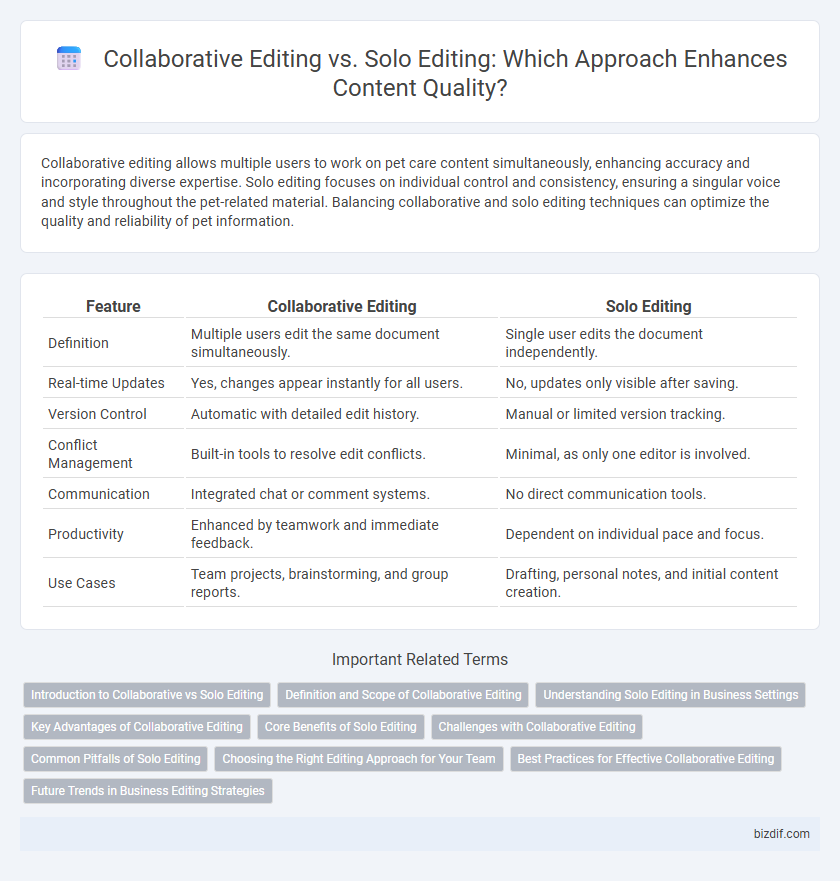Collaborative editing allows multiple users to work on pet care content simultaneously, enhancing accuracy and incorporating diverse expertise. Solo editing focuses on individual control and consistency, ensuring a singular voice and style throughout the pet-related material. Balancing collaborative and solo editing techniques can optimize the quality and reliability of pet information.
Table of Comparison
| Feature | Collaborative Editing | Solo Editing |
|---|---|---|
| Definition | Multiple users edit the same document simultaneously. | Single user edits the document independently. |
| Real-time Updates | Yes, changes appear instantly for all users. | No, updates only visible after saving. |
| Version Control | Automatic with detailed edit history. | Manual or limited version tracking. |
| Conflict Management | Built-in tools to resolve edit conflicts. | Minimal, as only one editor is involved. |
| Communication | Integrated chat or comment systems. | No direct communication tools. |
| Productivity | Enhanced by teamwork and immediate feedback. | Dependent on individual pace and focus. |
| Use Cases | Team projects, brainstorming, and group reports. | Drafting, personal notes, and initial content creation. |
Introduction to Collaborative vs Solo Editing
Collaborative editing involves multiple users working simultaneously on the same document, enhancing creativity and accelerating revisions through diverse input. Solo editing, by contrast, relies on individual effort to refine content, ensuring a singular voice and focused decision-making. Understanding the strengths of collaborative versus solo editing helps optimize workflow and improve content quality in various projects.
Definition and Scope of Collaborative Editing
Collaborative editing involves multiple contributors working simultaneously or asynchronously on the same document, enhancing content quality through diverse perspectives and real-time feedback. This approach leverages digital platforms like Google Docs or Microsoft OneDrive, enabling seamless version control and conflict resolution. Unlike solo editing, collaborative editing expands the scope to include teamwork dynamics, shared responsibilities, and iterative refinement processes.
Understanding Solo Editing in Business Settings
Solo editing in business settings offers complete control over content quality, ensuring a consistent voice and style aligned with company branding. It streamlines decision-making processes, reducing the risk of conflicting edits and speeding up project timelines. However, solo editing may limit diverse perspectives, which can be critical for detecting errors and enhancing creativity in complex projects.
Key Advantages of Collaborative Editing
Collaborative editing enhances content accuracy by allowing multiple experts to contribute diverse perspectives and catch errors that a single editor might miss. It accelerates the revision process, enabling real-time feedback and seamless integration of changes. Increased creativity and improved decision-making result from collective brainstorming, leading to higher-quality, well-rounded final outputs.
Core Benefits of Solo Editing
Solo editing enhances creative control by allowing editors to make decisions without external influence, ensuring a cohesive and consistent vision throughout the project. It accelerates the workflow by eliminating delays associated with coordinating multiple collaborators, enabling faster adjustments and refinements. Personal accountability in solo editing fosters a deeper connection to the material, often resulting in a more polished and authentic final product.
Challenges with Collaborative Editing
Collaborative editing presents challenges such as version control conflicts, inconsistent stylistic choices, and difficulties in real-time communication among team members. Coordination issues often arise when multiple editors work simultaneously on the same document, leading to overlapping changes or accidental deletions. Ensuring cohesive final output requires robust collaboration tools and clear guidelines to manage diverse input and maintain content integrity.
Common Pitfalls of Solo Editing
Solo editing often leads to limited perspective, increasing the risk of overlooking errors or inconsistencies in tone and content. Without collaborative feedback, issues such as biased interpretations, unnoticed factual inaccuracies, and weak argumentation can persist, reducing the overall quality of the text. Reliance on a single editor also heightens the chance of burnout and slows the revision cycle, impacting productivity and effectiveness.
Choosing the Right Editing Approach for Your Team
Collaborative editing enhances project quality by leveraging diverse perspectives, accelerating revisions, and ensuring consistent content alignment among team members. Solo editing offers greater control and efficiency for straightforward tasks or when individual expertise is paramount, reducing potential conflicts. Evaluating team size, project complexity, and workflow preferences helps determine the optimal editing approach for maximizing productivity and final output quality.
Best Practices for Effective Collaborative Editing
Effective collaborative editing thrives on clear communication protocols, version control systems like Git or Google Docs, and predefined roles to prevent overlap and conflicts. Establishing consistent style guides and real-time feedback loops ensures document coherence and improves overall quality. Leveraging collaborative platforms enhances transparency, accountability, and accelerates the editing workflow.
Future Trends in Business Editing Strategies
Future business editing strategies emphasize collaborative editing platforms powered by AI, fostering real-time teamwork to enhance document accuracy and efficiency. Solo editing remains crucial for specialized content, but integration with collaborative tools ensures streamlined feedback loops and reduced revision times. Advancements in cloud technology and machine learning further facilitate seamless editing workflows, driving innovation in business communication.
Collaborative Editing vs Solo Editing Infographic

 bizdif.com
bizdif.com